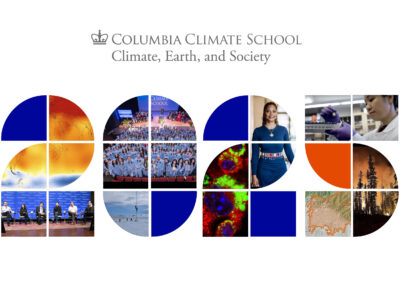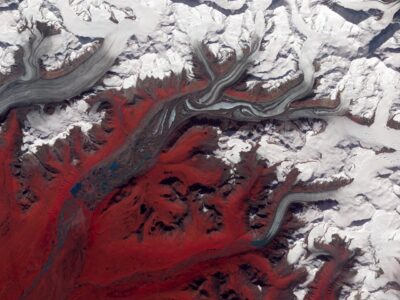
In a powerful new iteration of the “Coal + Ice” exhibit, on display at the Asia Society in New York through August 11, the immersive works of over 30 photographers highlight the causes and consequences of climate change through a people-focused lens.
The show asks viewers to stare directly and unflinchingly at our changing global landscape and to reflect on how we got here.
Through an interactive photographic arc, the exhibit offers a humanistic narrative of the history of climate change, beginning with portraits of coal miners, such as the one by Geng Yunsheng shown below. The exhibit then transitions into images showcasing the disappearing glacial ice across the Himalayas and the world. The final series of photographs depicts the harrowing consequences of climate change that people face, such as floods and wildfires.

“The power of art is that it reaches you at a level that is not just rational thinking; it’s emotional. It’s why some pieces in the show continue to resonate with you,” Vishakha N. Desai, senior research scholar for the School of International and Public Affairs and senior advisor for global affairs to the president at Columbia University, said in a recent interview with GlacierHub.
“Don’t expect art to do what policy changes can do. Don’t expect art to do what active community engagement and action can achieve. But art can put the issue on the table in a way that opens up new ways of looking at things,” Desai, who served as president and CEO of the Asia Society from 2004 through 2012, said.
“Coal + Ice” premiered in 2011 at the Three Shadows Photography Art Centre in Beijing, China. Recognizing the potential for climate collaboration between the U.S. and China—the two largest global carbon emitters and major coal producers—the exhibit has since traveled to Shanghai, San Francisco and Paris, before coming to New York.
“The more art and science are done together, the better,” Elizabeth Case, a glaciologist, educator, artist and Ph.D. student at Columbia Climate Lamont-Doherty Earth Observatory, said. “We need to engage people’s hearts and minds through connection and community.”

One way “Coal + Ice” has engaged its audience is through its third-floor exhibits, which are dedicated to solution-based interaction. These include Maya Lin’s “What Is Missing?” memorial, which depicts videos of extinct or soon-to-be extinct species and places and contains a portal where people can submit their personal memories of the planet, like reminiscences of melting ice or changing landscapes.
In the video installation, “Deluge,” by the artist and activist Gideon Mendel, striking images of people submerged in floods, alongside some of the homeowners’ personal photographs— now warped from water damage—appear on screen.
Occupying an entire room within the exhibit, “Deluge” creates a powerful experience for viewers as they consider Mendel’s subjects. Each image depicts a different person, couple or family impacted by the floods. They all direct an unwavering gaze forward, almost questioning viewers on their “communal culpability for their plight.”
“I want people to look, and to look again, and look deeper… They’re drawn into a very visually impeding image, but actually, the content is quite traumatic. It’s aesthetic, but also a disturbing and unsettling experience,” Mendel explained.

Award-winning photographer and TED senior fellow Camille Seaman focuses her art and photography on ice and the changing natural environment. Her photograph, “Iceberg in Blood Red Sea,” is also featured in the “Coal + Ice” exhibit. She captured the image in Antarctica on a chilly December night, where after a long day, she got the feeling that something was going to happen, she told GlacierHub. She stayed up past 2 AM—the skies still light in the Southern Hemisphere summer—until she witnessed an unusual landscape: a blood-red sky reflecting onto the ocean around an iceberg. “It was one of the few times in my career as a photographer where I had to keep putting the camera down and looking to make sure that what I was seeing was what I was actually seeing through the camera, as far as the color, as far as the light,” she said of the photograph.

“Being connected to my Afro-Indigenous heritage, it is very important for me to articulate as much as possible through my work, that everything is interconnected and interrelated, and that we as humans are not separate from nature,” she said.
“Coal + Ice” shows how the two entities named in its title are linked—and how humanity’s continued use of the former is leading to the demise of the latter, with devastating effects around the world. It challenges visitors to contemplate both the environmental and human consequences of climate change and creates an opportunity for people to reflect on their position in a world where responses to these forceful interactions remain inadequate.
“Coal + Ice” is on display in New York until August 11, 2024, at the Asia Society, a nonprofit founded in 1956 whose purpose is to “navigate shared futures for Asia and the world across policy, arts and culture, education, sustainability, business, and technology.”



